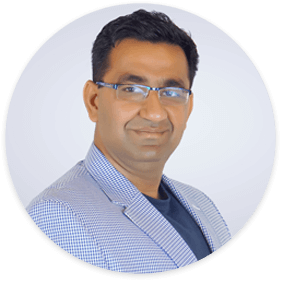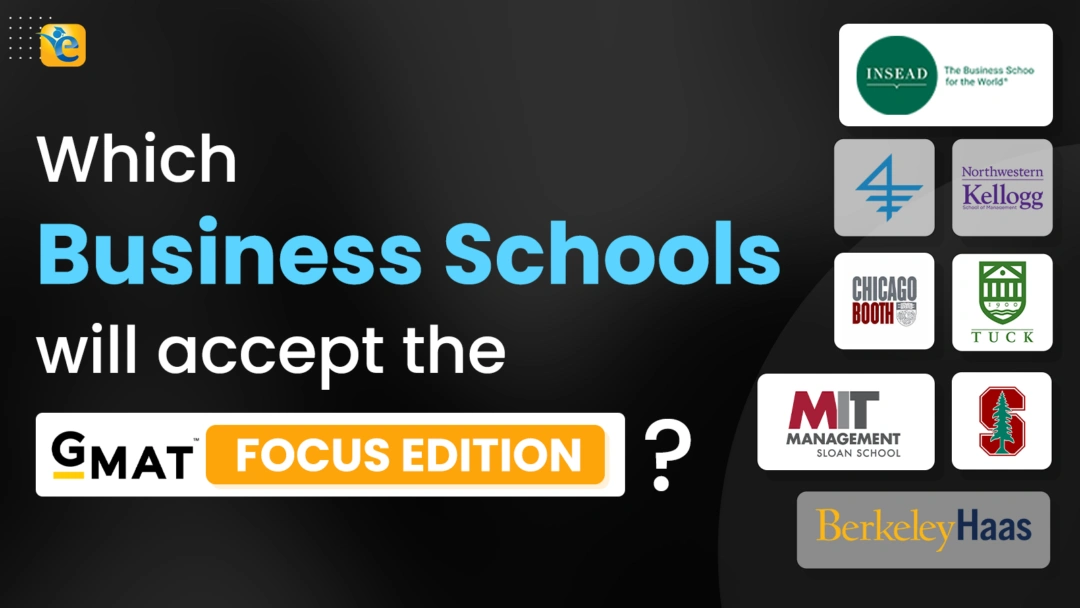GMAT vs CAT – After the announcement of this new exam pattern of GMAT exam – GMAT Focus Edition (GFE) – the primary difference between the GMAT and CAT exams lies in their scope and recognition. The GMAT is a global exam accepted by over 2400 business schools and 7700 MBA programs worldwide. In contrast, the CAT is a national-level entrance exam accepted only by Indian business schools. But is that the only difference? In this article, we explore key differences in eligibility, syllabus, exam fees, difficulty, and score validity to help you decide which exam is better suited for you: CAT or GMAT?
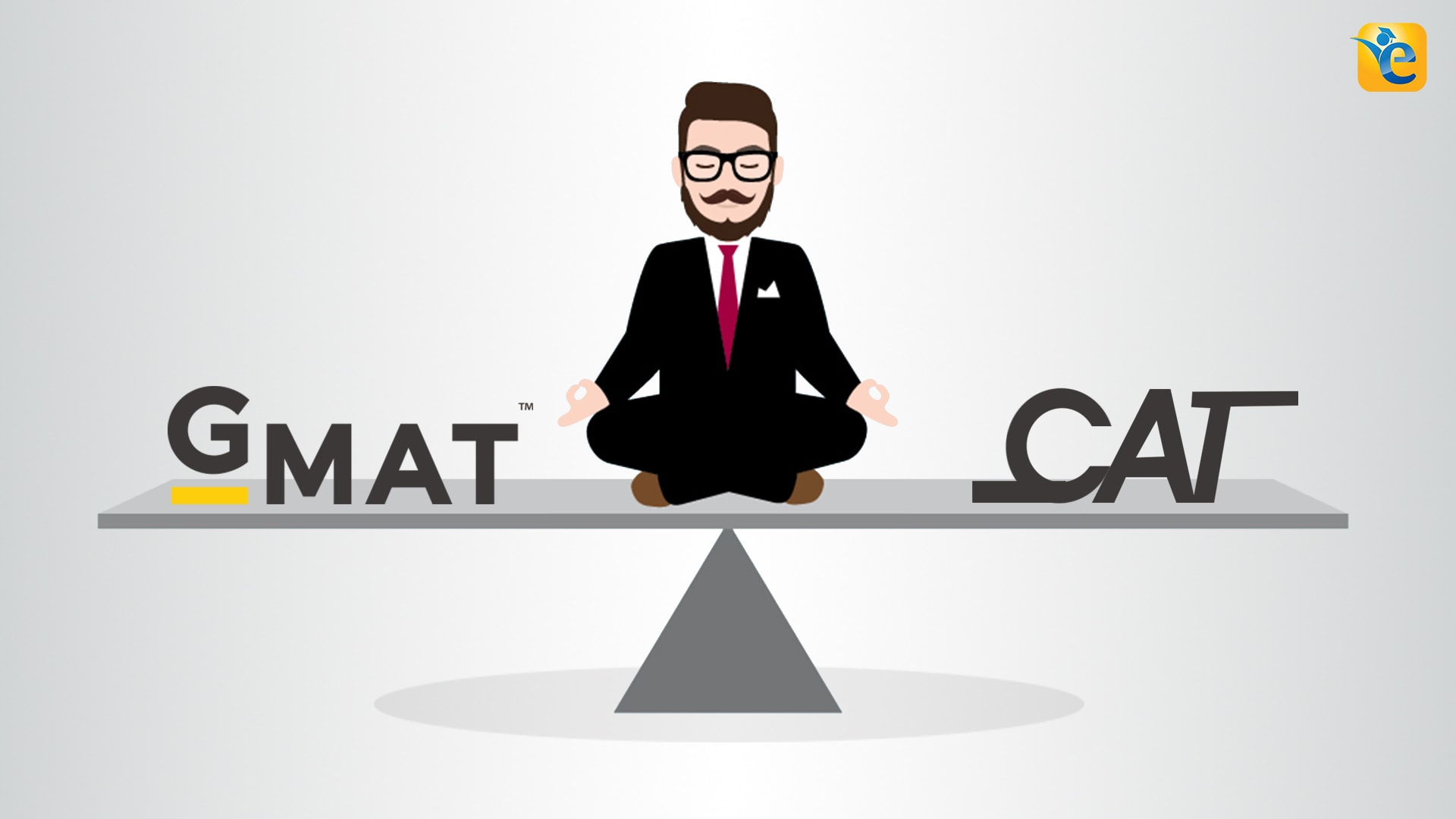
What is the GMAT exam?
The GMAT is conducted by the Graduate Management Admission Council (GMAC). Apart from top institutions across countries including the U.S., the UK, Europe, Singapore and Canada, a GMAT score is also accepted for flagship programs with (or without) work experience by top MBA colleges in India.
Top Indian B-Schools accepting GMAT Scores for freshers are –
- S P Jain Institute of Management & Research, Mumbai
- Great Lakes Institute of Management, Chennai
- XIM, Bhubaneswar
- IMT, Ghaziabad
- IMI, Gurgaon
- BITS, Pilani
- K J Somaiya, Mumbai
- T A Pai Management Institute (TAPMI), Manipal
- Welingkar Institute of Management Development & Research, Mumbai
- Goa Institute of Management, Goa
- FORE School of Management, New Delhi NCR
Top Indian B-Schools accepting GMAT Score with Work experience are –
- ISB, Hyderabad & Mohali, 2+ years
- IIM Ahmedabad | PGPX Program, 5+ years
- IIM Calcutta | PGPEX Program, 5+ years
- IIM Bangalore | ePGP Program, 5+ years
- IIM Lucknow | IPMX Program, 5+ years
- IIM Indore | EPGP Program, 5+ years
- XLRI Jamshedpur | PGDM (General Management), 5+ years
Therefore, deciding between taking the GMAT and CAT is a dilemma faced by countless Indian MBA aspirants as both serve as stepping stones to gaining admission into an MBA program.
We will help you in deciding how to choose GMAT vs CAT entrance exam?
Confused between taking the GMAT or CAT for your MBA? Get a better understanding of both tests by taking our free GMAT mock test and free trial. Get a baseline score and detailed insights into your performance to make an informed decision about which exam to choose. We are the most reviewed GMAT prep company on the GMAT club with more than 2600+ reviews and have delivered more 700+ scores than any other GMATClub partner. Don’t wait, take the first step towards your MBA journey today!
What is the Difference between CAT and GMAT?
Both the GMAT and the CAT serve as standardized tests for admission to MBA programs. However, both differ in the scope of their acceptability, validity, fees, frequency of the exam, format and more.
GMAT is a global exam accepted by more than 7000 MBA programs in 110 countries, whereas CAT is accepted only by Indian business schools. Also, the GMAT score is valid for 5 years, whereas the CAT score is only valid for 1 year. GMAT has an exam fee of $275 (approx. Rs 22,820) for test centers and $300 (approx. Rs 24,900) for the online test, whereas CAT has a registration fee of Rs 2400. While the GMAT can be given multiple times a year and at any time of the year, depending on the slot availability, CAT can only be given once a year on the date decided by the IIM conducting the exam.
Despite the many differences, both the CAT and GMAT are tests that measure your management skills such as:
- Quantitative ability
- Reasoning skills
- Data Interpretation
However, there are quite a few fundamental differences between these exams. Take a look at the table below to see a few differences between GMAT and CAT in 2024:
| GMAT vs CAT | CAT | GMAT |
| Full-Form | Common Admission Test | Graduate Management Aptitude Test |
| Conducting body | Indian Institute of Management | Graduate Management Admission Council |
| Validity | One year | Five years |
| Eligibility | Bachelor’s degree with a minimum of 50% marks | At least 13 years of age |
| Can Be Taken How Many Times in a year? | 1 | 5 |
| Accepted by | Indian business schools | Global business schools |
| Mode of Exam | Online | Online |
| Number of sections | 3 | 3 |
| Number of questions | 66 (24 in VARC, 22 in QA, 20 in DILR) | 64 (21 in QR, 23 in VR, 20 in DI) |
| Exam Duration | 120 minutes | 135 minutes |
| Exam Fee | ₹2,400 | USD $275 |
| Negative Marking | Yes | No |
| Mode of Exam | Test Center | Test Center or online at home |
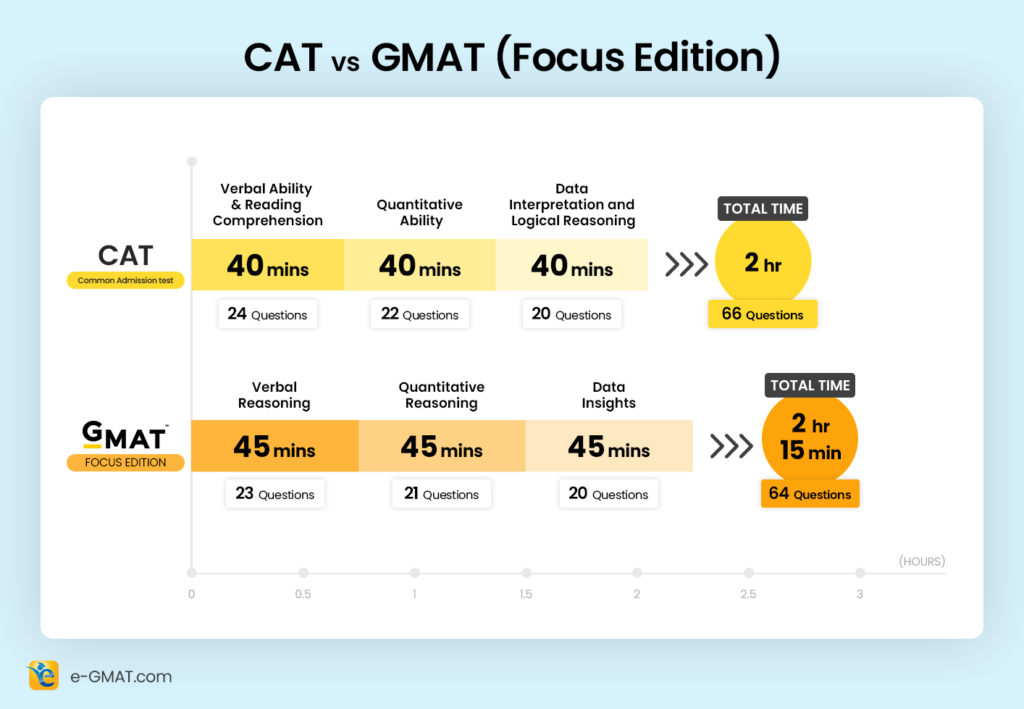
Planning to pursue MBA? Watch this video where we discuss the top 5 reasons to pursue an MBA:
Let us now understand the difference between the GMAT and CAT exam structure:
Format and Duration
The CAT and the GMAT both consist of 3 sections. Though both the GMAT and the CAT are computer-based tests, the GMAT is adaptive in nature whereas the CAT isn’t. This means that on the GMAT, the difficulty level of the next question is decided based on your performance in the previous question. On CAT, the questions are all pre-decided and do not change with your performance on preceding questions.
The CAT lasts for 2 hours while the GFE lasts for 2 hours and 15 minutes.
The GMAT is delivered on-demand around the year via Pearson Vue testing facilities at 125+ centers across India. Read our other article to know more about GMAT Test centers and the testing environment.
The CAT is conducted by one of the 20 IIMs in a rotational fashion. The dates of the test are announced by the convening IIM in either July or August of every year.
Score Validity
Your GMAT score is valid for 5 years from the date of your test. This is because GMAC (the organization that conducts the GMAT) believes your reasoning skills and abilities would not erode substantially over a 5-year period.
However, business schools may have their own policies with regard to the score that they accept. Make sure you check with your target school before you apply.
On the other hand, CAT scores are valid for just 1 year from the date of the test. Also, if you are not able to score well in an attempt, you would have to wait for a year to take it again.
This is not the case with the GMAT as it can be taken on demand (at most 5 times a year). The opportunity cost of waiting for a year would be a consideration for a lot of candidates.
Five reasons why undergraduates should take the GMAT- Read this article to know more.
Eligibility and Attempts
Anyone over 18 years of age can take the GMAT. If you’re below the age of 18 i.e. 13-18 years of age, then, with parental permission you can take the GMAT.
You can take the GMAT up to 5 times a year. The minimum duration between any attempts should be at least 16 days. There is an 8-attempt overall lifetime limit.
The CAT can be taken only once every year on a date specified by the convening IIM. The date on which the CAT will be conducted is announced by the convening IIM in July or August of every year.
There is no restriction on the number of attempts you can take the CAT and no upper age limit. However, to attempt the CAT you need to have a bachelor’s degree from a recognized institution or its equivalent. Students in the final year of their respective degree programs can also appear and take the CAT.
Thus, the GMAT due to its on-demand nature and opportunity for score improvement and scheduling flexibility is the better option.
Exam Fees and Average Salaries
It costs $275 to register for the GMAT. You can schedule and book an appointment after creating and registering an account on mba.com.
Read this article to know more about how much does it cost to take the GMAT exam in India.
The registration and test fee for CAT is INR 2400/-. The convening IIM releases a notification generally in the months of July or August.
The details related to the dates of registration, exam fees, and other information are included in this notification released by convening IIM. Since the CAT is not administered on demand you must be careful about the deadlines for registration. Here is the link to the notification of CAT 2023.
The average salary offered to IIM graduates of the Top -10 IIMs is between the range of INR 25-30 lakhs The highest international offer made to an IIM graduate stands at INR 1.32 Crore. Whereas, the average salary offered to graduates of the top 25 MBA programs globally are significantly higher ~ INR 1.05 Crore.
Did you know a GMAT score of 730+ yields incremental $500K in ROI?
Start your GMAT Preparation by Signing up for our FREE Trial and get access to FREE online GMAT preparation resources. Take a free GMAT mock to understand your baseline score and start your GMAT prep with our free trial. We are the most reviewed online GMAT Prep company with 2600+ reviews on GMATClub.
Here are the key differences between the GMAT and CAT exam structure:
| Parameter | GMAT | CAT |
| Sections | 3 Sections · Quantitative reasoning (QR) ·Verbal reasoning (VR) · Data Insights (DI) | 3 Sections ·Verbal ability and reading comprehension (VARC) ·Data Interpretation and logical reasoning (DILR) ·Quantitative Ability (QA) |
| No. of Questions/ Time limit | 64 Questions in total QR – 21 Questions / 45 Minutes VR – 23 Questions / 45 Minutes DI – 20 Questions / 45 Minutes | 66 Questions in total QA – 22 Questions / 40 minutes VARC – 24 Questions / 40 minutes DILR – 20 Questions / 40 minutes |
| Test Duration | 2 Hours and 15 Minutes | 2 Hours |
| Adaptiveness | Question adaptive | Not adaptive |
| Score reporting | Absolute score (Out of 805) and percentile score reported | Only Percentile score reported |
| Score Validity | 5 Years | 1 Year |
| Scheduling Flexibility | Delivered on-demand, can be taken up to 5 times a year. With at least 16 days between attempts. | Conducted only once a year. |
| Test Fee | $ 275 – Test Center Version and $300 – Online version | INR 2,400 (General category) and INR 1,200 (Reserved category) |
| Eligibility | ·Lower age limit – 13 years · Upper age limit – None | · No lower age limit but bachelor’s degree from a recognized university or equal qualification required. · No upper age limit |
| Number of Attempts | · Maximum 5 attempts in a year (Minimum 16 days between consecutive attempts) · Lifetime Limit of 8 attempts overall | · Can be attempted only once every year. · No limit on the number of attempts. |
| Acceptance | · 7000+ programs (Including ISB, SPJIMR, MDI, IIMs (Executive Programs) · Accepted by business schools in 110 countries [1] | ·20 IIMs · Other management colleges in India (SPJIMR, FMS, MDI, IMT, IIFT) ·Accepted for admission in India only |
Comparison of the relative difficulty | Is GMAT easier than CAT?
The GMAT has a very well-defined syllabus and question types, thus it is easier to prepare for GMAT than the CAT. It is possible to rank at the 86 percentiles on the GMAT with 90 – 120 hours of dedicated preparation.
On the other hand, the CAT syllabus is not very well defined, and thus more preparation time is required as compared to the GMAT.
The verbal section of the GMAT generally poses a greater challenge for Indian test takers who are non-native English speakers as compared to the CAT. The Quantitative section of the CAT is relatively more difficult than the GMAT.
Did you know you can take the GMAT at home? Watch this video to know more. You can also check out our article on GMAT online exam.
New GMAT vs CAT
Are you confused about whether to take the GMAT or CAT exam?
With a test structure that is now more like the CAT, the GMAT Focus edition is a game changer for students looking to prepare for both the exams- CAT and GMAT. The gap between the two exams has significantly reduced with the introduction of the GMAT Focus edition.
Test takers looking to take the GMAT and who have previously prepared for CAT will have a significant advantage in the new Data Insights section of the GMAT Focus edition. Additionally, the GMAT Focus edition will no longer include the AWA section, which was present in the earlier version of the GMAT.
In addition to the new section, the GMAT Focus edition will feature section durations similar to the CAT. The new version of the GMAT will have three sections of 45 minutes each, just slightly longer than the CAT’s 40-minute sections. Here are some of the key differences between CAT, the new GMAT- GMAT focus edition, and the current GMAT-
CAT vs GMAT Focus Edition
| Parameter | CAT | GMAT Focus edition |
| Test duration | 2 hours | 2 hours 15 minutes |
| No of sections | 3 | 3 |
| Name of the sections | Quantitative Ability (QA) · Verbal ability and reading comprehension (VARC) ·Data Interpretation and logical reasoning (DILR) | Quantitative reasoning (QR) ·Verbal reasoning (VR) · Data Insights (DI) |
| Section duration | 40 minutes each | 45 minutes each |
| No of questions | 66 Questions in total QA – 22 Questions VARC – 24 Questions DILR – 20 Questions | 64 Questions in total QR- 21 Questions· VR- 23 Questions · DI- 20 Questions |
Preparing for both the GMAT and CAT exams simultaneously or back to back has never been easier, thanks to the significant overlap in their syllabus. To maximize your preparation, focus on improving your Data Insights skills, in addition to quantitative and verbal reasoning skills. Remember to leverage the similarities between the exams to increase your chances of success. Read this article to understand more about how to leverage your CAT preparation to ace the GMAT
To help you familiarize yourself with the exam formats and achieve your target scores, we recommend taking advantage of our free mock test and free trial. Our FREE GMAT mock test provides a detailed analysis of your performance and establishes your baseline score. Additionally, our free trial grants you access to over 10 hours of AI-driven video lessons and 400+ GMAT practice questions.
Don’t miss this opportunity to ace both exams. Sign up for our free mock test and free trial today!
What is tested in each of these exams? – Difference in Syllabus
The gap between the two exams has significantly reduced with the introduction of the GMAT Focus edition.
GMAT vs CAT – Verbal syllabus
The biggest change in the Verbal section in GMAT is the complete removal of Sentence Correction from the syllabus.
The following verbal topics are asked on the GMAT and CAT –
| CAT | GMAT |
| Fill in the blanks | Verb tense |
| Grammar | Pronoun |
| Para Completion and inference | Subject-verb agreement |
| Reading Comprehension | Modifiers |
| Verbal Logic | Idioms |
| Para jumbles | Parallelism |
| Verbal Reasoning | Comparison |
| Syllogisms | Inference |
| Contextual usage | Assumption |
| Analogies | Evaluate |
| Different usage of the same word | Strengthen and weaken |
| Antonyms | Boldface |
| Sentence completion | Paradox |
| Jumbled paragraphs | |
| Foreign language words used in English | |
| Sentence correction | |
| Idioms | |
| One word substitution |
GMAT vs CAT – Quant syllabus
The biggest change for the Quant section in GMAT (Focus Edition) is the removal of Geometry. Apart from this, the following Quant topics are asked on the GMAT and CAT.
| CAT | GFE |
| Geometry | Number properties |
| Trigonometry | Multiples and factors |
| Mensuration | Fractions |
| Ratios and Proportion | Decimals |
| Number system | Percentages |
| Work and time | Averages |
| HCF & LCM | Exponents |
| Algebra | Profit and loss |
| Profit & Loss | Simple and compound interest |
| In-equations Quadratic and linear equations | Speed, time, and distance |
| Geometric Progression | Pipes, cisterns, and time work |
| Arithmetic Progression | Ratio and proportion |
| Averages | Mixtures and allegations |
| Partnership (Accounts) | Descriptive statistics |
| Time-Speed-Distance | Set theory |
| Surds and Indices | Probability |
| Inequalities | Permutation and combination |
| Logarithms | Monomials, polynomials |
| Percentages | Algebraic expressions and equations |
| Functions | |
| Arithmetic and Geometric progression | |
| Quadratic equations | |
| Inequalities and basic statistics |
GMAT vs. CAT – Adaptive vs. non-adaptive
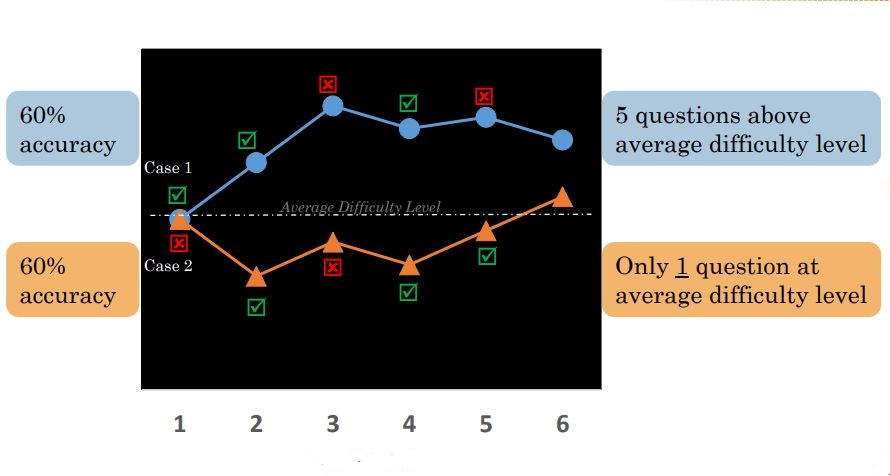
The GMAT is an adaptive test. This means that the difficulty level of your next question depends on your performance in the previous question.
Thus, the GMAT is a test of ability as it constantly adapts and refines the test to your ability level. The test starts off with a question of medium difficulty, if you answer this question correctly, the next question is of a slightly higher difficulty level. Hence, there is no option to review your answers or skip a question.
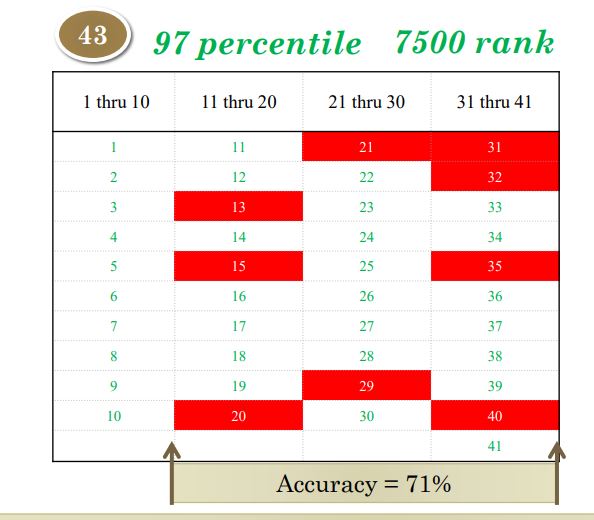
Let us understand this better with the help of an example of 2 students taking the GMAT:
Student 1:
This student starts with a question of medium difficulty. After answering this question correctly, the student receives a question of a higher difficulty level.
Once the student answers this question correctly the next question is of slightly higher difficulty. The performance of this student can be plotted on a graph as shown above.

Student 2:
This student starts in a similar way to student 2. However, the student incorrectly answers the first few questions presented to him.
Analysis and takeaways
Now, since student 1 answers initial questions and quite a few of the proceeding questions correctly, the GMAT testing algorithm rightly judges this candidate to have a higher ability as he has correctly answered questions of higher difficulty. This is reflected in this student’s higher GMAT score.
However, since student 2 answers the initial few questions incorrectly, the algorithm does not present his questions of a higher difficulty level. Thus, this student is judged to have a lower ability and hence a lower GMAT score. even though the student may have answered more questions correctly overall.
The conclusion here is that the GMAT is a test of ability rather than accuracy.
Learn more about how the Computer Adaptive GMAT works in this article.
CAT, on the other hand, is a non-adaptive test and focuses on accuracy rather than ability. Since in the CAT only percentile scores are reported, your score depends solely on how many questions you answered correctly. You can review your answers in a section before submission. Also, an on-screen calculator is provided. There is a negative marking for wrong answers.
Are you planning to enroll in a US business school? Let us help you conquer the first step of the process i.e., taking the GMAT. Take a free GMAT mock to understand your baseline score and start your GMAT prep with our free trial. We are the most reviewed online GMAT Prep company with 2600+ reviews on GMATClub.
What factors to consider in choosing GMAT or CAT? | How to choose between GMAT vs CAT
In deciding how to choose between GMAT and CAT, you should take the following factors into consideration:
- Your career goals
- Choice of program
- Location preference
- Investment vs return
Let us explore each of these one by one to understand how to choose GMAT vs CAT?
Career Goals
Besides the 20 IIMs, more than 100 other B-schools all over India accept CAT scores for admission into graduate management programs. A few international business schools also accept CAT scores for admission into management programs. Some of the international schools that accept CAT scores are:
| Sr No | School/University | Program | Location |
| 1 | SP Jain Institute of Management | MBA | Sydney/Dubai/Singapore |
| 2 | SKEMA Business School | MiM | France |
| 3 | Singapore Management University | MiM | Singapore |
The GMAT is accepted for admission into graduate management programs at more than 7000 programs across 2,300+ graduate business schools worldwide. Some of the world’s top-ranked business schools accept GMAT scores for admission into their graduate management programs such as:
If your career goal is to study abroad and gain valuable international exposure and work experience, then the GMAT is the obvious choice because of its wider acceptance globally. The GMAT is further gaining acceptance as an admission criterion for Executive programs at some of the top Indian B-schools.
140+ Indian Business Schools are now accepting GMAT Scores for admission into management programs, including IIMs for their Executive programs. Learn more about the scope of GMAT in India.
On the contrary, if your primary goal is to live and work in India at some of the best domestic as well as global employers, then the CAT is the preferred choice.
Choice of Program
Depending on your target B-school and its program admission requirements, you may need to take either the GMAT or CAT.
E.g., If your target program is the regular 2-year, the full-time residential MBA program at any IIM then you must have a valid CAT score. However, if you are considering the 1-year full-time executive program (EPGP/PGPEx) then a valid GMAT score is accepted.
Also, since the IIMs conduct the CAT, it is a better predictor of success in the programs they offer, as it tests for the skills that are required to succeed in the program.
Note: If you are an international or overseas student, your GMAT score is considered for admission into some of the top programs at Indian B-schools.
E.g., If you want to study at ISB, then a GMAT score is necessary as it is the only accepted test score besides the GRE.
Location Preference
If you have decided to study in a particular geographical location, due to the proximity of employers in your target industry; then this is a factor you should consider in deciding which test to take between GMAT or CAT.
E.g., If you are looking for a role in luxury management, for which the best employers are in France. It would be best to pursue an MBA from a B-school around that area as this would place you in close proximity with your target employers and open up opportunities for internships as well.
Investment vs Return (GMAT vs. CAT)
In the table below is a breakdown of the costs involved if you’re considering taking either test:
| Sr No | Expense | GMAT | CAT |
| 1 | Test Fee | $275 | $ 29 |
| 2 | Preparation Cost | $349 (e-GMAT course) | $ 450 (Average Cost of CAT coaching in-classroom programs) |
| 3 | Cost of rescheduling | $50 – More than 60 days prior to appointment $100 – 15 to 60 days prior to appointment $150 – 1 to 14 days prior to appointment | Conducted only once a year (rescheduling not possible) |
| 4 | Score reporting | $35 each (First 5 reports are free) | Reported to all IIMs free of cost. |
| 5 | Enhanced score report | $30 | Not available |
| 6 | Score Validity | 5 Years | 1 Year |
| 7 | Total Cost | $ 829 | $ 480 |
| 8 | Total cost per year | $ 166 | $ 480 |
In the cost comparison shown above, we have considered the USD to INR conversion rate as (1 USD = 83 INR) and the average preparation cost of one of the most popular classroom coaching available for the CAT.
Did you know a GMAT score of 730+ yields an incremental $500K in ROI? Start your GMAT Preparation by Signing up for our FREE Trial and get access to FREE online GMAT preparation resources. We are the most reviewed GMAT preparation company on GMATClub with more than 2600+ reviews.
Which is better CAT or GMAT? || Few key points to note for GMAT vs CAT
- Since the CAT is conducted only once a year, if you do not make the cut-off for your target college/program your only option is to wait another year to take it again, whereas the GMAT can be taken multiple times with a minimum of 16 days between attempts.
- Thus, the opportunity cost is quite higher in the case of the CAT. On the other hand, since you can take the GMAT multiple times, with better preparation and strategy you can improve your score and your profile to suit your target program better.
- The GMAT Enhanced Score Report (ESR) offered at an additional cost, could provide valuable insights into your performance. Developing your retake strategy based on your ESR analysis could be of immense benefit. No such facility is available for the CAT.
- Also, since your GMAT score is valid for five years from the date of your test, the actual cost for the GMAT comes down to $166/year.
Graduates of the top 25 business schools in the US 2022 earn greater than $ 150,000 in starting salaries. With graduates of the top 10 schools making more than $ 200,000 a year. In contrast to this, the highest international offer made to an IIM-A student in 2022 was INR 1.32 crore ($ 1,59,000).
Thus, the key takeaway here is, that a good GMAT score consistently gives better ROI than the CAT.
Scholarships – The added advantage of GMAT over CAT
A good GMAT score helps not only in getting into a top business school, but it also increases the chances of securing a partial scholarship or a full fellowship. These can help immensely with the cost of doing an MBA.
To offset the increase in the cost of an MBA, top business schools are increasingly offering scholarships, fellowships and other forms of financial aid. Harvard Business School offered some form of financial aid to 50% of its incoming class.
Scholarships offered by programs to business school students crossed $ 230 Million in 2017.
Read our article on scholarships and GMAT score, to learn more about how to secure a scholarship at a top Business school.
Scholarships based on CAT score
While some form of need-based financial assistance is offered at most IIMs, they are in the form of loans rather than scholarships.
Scholarships offered by companies and private entities are also available to students.
An exhaustive list of scholarships available can be found here.
More information about the scholarships available at each institution can be found on the institution’s website.
Takeaways – How to choose between GMAT vs CAT?
The following criteria should help you in deciding GMAT vs CAT
- Decide on your career goals (International Exposure and Work Opportunities vs. Domestic)
- Choice of Program (Executive, Full-time 1 year, Full Time 2 years)
- Location Preference (India v.s. Abroad)
- Investment vs. Return (GMAT vs CAT)
- Scholarship Opportunities (GMAT vs CAT)
In conclusion, the GMAT with its wider worldwide acceptance, lower opportunity cost, and greater return on investment along with its increasing acceptance to executive MBA programs at IIMs and a few other Indian B-schools stands out as the better option between GMAT vs CAT. However, if you are aiming for admission into the traditional 2 year MBA program at IIMs or other business schools in India such as MDI or SPJIMR, then the CAT may be your only choice.
We hope this article provides you with the information to decide between the GMAT and CAT. Please write to us with your questions at acethegmat@e-gmat.com.
Are you planning to enroll in a US business school? Let us help you conquer the first step of the process i.e., taking the GMAT. Take a free GMAT mock to understand your baseline score and start your GMAT prep with our free trial. We are the most reviewed online GMAT Prep company with 2600+ reviews on GMATClub.
GMAT vs CAT- Frequently Asked Questions (FAQs)
Yes, only the timings of each section have changed in CAT 2021. Previously, you were given 60 minutes per section. Now, you’ll be given 40 minutes per section for CAT 2023. The number of questions has remained unchanged.
More than 7000 MBA programs of 2500+ business schools worldwide accept GMAT score for their admissions process.
More than 1200 MBA colleges in India apart from the 20 IIMs accept CAT for their MBA pr PGDM programs
You can take the GMAT 5 times in a calendar year whereas you can only take CAT once in a year.
GMAT score is valid for 5 years and a CAT score is only valid for one year.
Yes, many IIMs and other non-IIM Indian Business schools accept GMAT scores for their 1 year Executive MBA programs.
A 645+ score is considered a good score for the executive MBA programs of the top IIMs. However, to be on the safer side, one should target to score 655+.
In the GMAT exam, there isn’t any negative marking. However, in the CAT exam, marks are deducted for wrong answers.
The GMAT exam is recognized worldwide, with more than 2300 premier institutions across 110+ countries such as the U.S., UK, Europe, Singapore, and Canada. Additionally, more than 140 leading institutions in India also accept GMAT scores for their flagship programs. On the other hand, CAT scores are accepted only by business schools in India, including the Indian Institutes of Management (IIMs).





